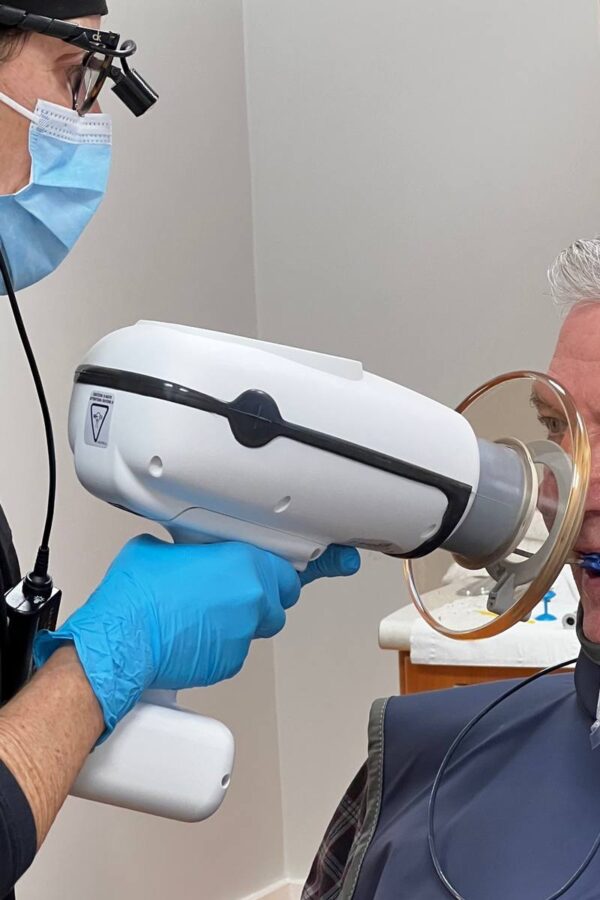
At the dental office you may hear a more technical word for an x-ray called a radiograph. A radiograph is like an inside snapshot of a specific area of the body and in dentistry this provides insight into a patient’s mouth. The x-ray is one of the most valuable tools in the dental “toolbox” since it allows the practitioner to evaluate inside and around the teeth where there could be a hidden dental condition like a cyst, abscess, gum disease, bone loss, tooth decay, or oral cancer.
Digital X-rays at Palm Dental Centre
The dental assistants and hygienists at Palm Dental use a nouveau handheld, battery powered x-ray system that has eliminated the need for big swing arm wall-mounted models. The name of the unit is Nomad suggesting that it roams around! Well, it does just that as it is shared between multiple operatories. Our Nomad produces high quality x-rays using electronic sensors (instead of x-ray film) that capture the image and convert it into digital greyscale pixels for immediate storage onto a computer. This high-resolution image is instantly viewed and enlarged so the dentist and hygienist can more readily see problem areas.
When do I need x-rays?
When you are a new patient at a dental office, the practitioner is likely to suggest getting a full mouth series (FMS) which is on average 18 small x-rays. This series of images gives the complete story of dental health which will be stored in your file and used as a baseline for any future treatment or to evaluate changes in your oral health. On subsequent visits to the same dental office, your x-ray requirements may be reduced to bitewings, but this varies by patient.
What are bitewings?
Bitewings are the small tabs the patient bites down on when holding the x-ray sensor (in the case of digital radiography) or film in position. Typically, these four x-rays are done to capture the image of the back teeth: pre-molars, and molars on both sides. They are an accurate and easy way to obtain a diagnostic take of your teeth’s condition. The frequency you need to have bitewings depends most commonly on your susceptibility to tooth decay. Generally, bitewings are taken every 1-2 years based on your unique clinical assessment.
What is radiation?
Radiation is energy that comes from a source and travels through space. The various types of radiation are categorized according to their wavelength. The shorter the wavelength the more energy the radiation has. High energy x-rays have shorter electromagnetic waves than visible light allowing them to penetrate skin and soft tissue. Since x-rays are beyond the visible spectrum (invisible to humans) we must exercise safe usage. Patient safety is always a dentist’s concern. Before taking x-rays, the dental practitioner places a lead apron (impenetrable to electromagnetic waves) over the patient for added protection.
Is dental x-ray radiation a concern?
The short answer is no. According to Xrayrisk.com and many other radiology experts, “in properly performed individual examinations, the potential health benefits almost always outweigh the potential for risk of radiation exposure.” This statement speaks of the widely accepted fact that the use of x-rays in a modern dental practice are extremely safe.
To give the radiation exposure better perspective, consider that 1 bitewing digital x-ray equals about 0.0031mSv (millisievert) while a 6-hour plane ride is about 0.035mSv or roughly 10 times the amount.
Worry free Nomad: the wrap-up!
Although digital x-rays reduce radiation up to 90% compared to the traditional dental x-rays, it is also reassuring to know there is another layer of security with the built in safety features of the Nomad unit itself. It has a lead-acrylic shield and special internal housing that blocks any radiation outside the diagnostic beam. This makes it extra safe for the dental team to use, patient after patient, day after day. The final benefit of the Nomad handheld system: your dental care provider never leaves you unattended to take the x-ray. This undivided chair time attention is veritably comforting for patients.
